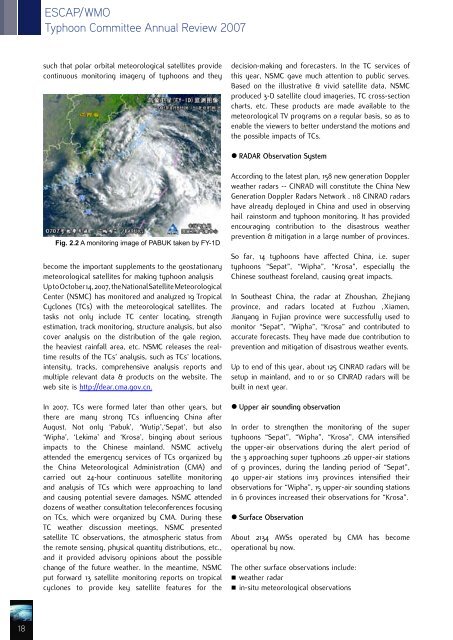200 - Typhoon Committee
200 - Typhoon Committee
200 - Typhoon Committee
Create successful ePaper yourself
Turn your PDF publications into a flip-book with our unique Google optimized e-Paper software.
ESCAP/WMO<br />
<strong>Typhoon</strong> <strong>Committee</strong> Annual Review <strong>200</strong>7<br />
such that polar orbital meteorological satellites provide<br />
continuous monitoring imagery of typhoons and they<br />
decision-making and forecasters. In the TC services of<br />
this year, NSMC gave much attention to public serves.<br />
Based on the illustrative & vivid satellite data, NSMC<br />
produced 3-D satellite cloud imageries, TC cross-section<br />
charts, etc. These products are made available to the<br />
meteorological TV programs on a regular basis, so as to<br />
enable the viewers to better understand the motions and<br />
the possible impacts of TCs.<br />
• RADAR Observation System<br />
Fig. 2.2 A monitoring image of PABUK taken by FY-1D<br />
become the important supplements to the geostationary<br />
meteorological satellites for making typhoon analysis<br />
Up to October 14, <strong>200</strong>7, the National Satellite Meteorological<br />
Center (NSMC) has monitored and analyzed 19 Tropical<br />
Cyclones (TCs) with the meteorological satellites. The<br />
tasks not only include TC center locating, strength<br />
estimation, track monitoring, structure analysis, but also<br />
cover analysis on the distribution of the gale region,<br />
the heaviest rainfall area, etc. NSMC releases the realtime<br />
results of the TCs’ analysis, such as TCs’ locations,<br />
intensity, tracks, comprehensive analysis reports and<br />
multiple relevant data & products on the website. The<br />
web site is http://dear.cma.gov.cn.<br />
In <strong>200</strong>7, TCs were formed later than other years, but<br />
there are many strong TCs influencing China after<br />
August. Not only ‘Pabuk’, ‘Wutip’,‘Sepat’, but also<br />
‘Wipha’, ‘Lekima’ and ‘Krosa’, binging about serious<br />
impacts to the Chinese mainland. NSMC actively<br />
attended the emergency services of TCs organized by<br />
the China Meteorological Administration (CMA) and<br />
carried out 24-hour continuous satellite monitoring<br />
and analysis of TCs which were approaching to land<br />
and causing potential severe damages. NSMC attended<br />
dozens of weather consultation teleconferences focusing<br />
on TCs, which were organized by CMA. During these<br />
TC weather discussion meetings, NSMC presented<br />
satellite TC observations, the atmospheric status from<br />
the remote sensing, physical quantity distributions, etc.,<br />
and it provided advisory opinions about the possible<br />
change of the future weather. In the meantime, NSMC<br />
put forward 13 satellite monitoring reports on tropical<br />
cyclones to provide key satellite features for the<br />
According to the latest plan, 158 new generation Doppler<br />
weather radars -- CINRAD will constitute the China New<br />
Generation Doppler Radars Network . 118 CINRAD radars<br />
have already deployed in China and used in observing<br />
hail,rainstorm and typhoon monitoring. It has provided<br />
encouraging contribution to the disastrous weather<br />
prevention & mitigation in a large number of provinces.<br />
So far, 14 typhoons have affected China, i.e. super<br />
typhoons “Sepat”, “Wipha”, “Krosa”, especially the<br />
Chinese southeast foreland, causing great impacts.<br />
In Southeast China, the radar at Zhoushan, Zhejiang<br />
province, and radars located at Fuzhou ,Xiamen,<br />
Jianyang in Fujian province were successfully used to<br />
monitor “Sepat”, ”Wipha”, “Krosa” and contributed to<br />
accurate forecasts. They have made due contribution to<br />
prevention and mitigation of disastrous weather events.<br />
Up to end of this year, about 125 CINRAD radars will be<br />
setup in mainland, and 10 or so CINRAD radars will be<br />
built in next year.<br />
• Upper air sounding observation<br />
In order to strengthen the monitoring of the super<br />
typhoons “Sepat”, “Wipha”, “Krosa”, CMA intensified<br />
the upper-air observations during the alert period of<br />
the 3 approaching super typhoons .26 upper-air stations<br />
of 9 provinces, during the landing period of “Sepat”,<br />
40 upper-air stations in13 provinces intensified their<br />
observations for “Wipha”, 15 upper-air sounding stations<br />
in 6 provinces increased their observations for “Krosa”.<br />
• Surface Observation<br />
About 2134 AWSs operated by CMA has become<br />
operational by now.<br />
The other surface observations include:<br />
• weather radar<br />
• in-situ meteorological observations<br />
18
















